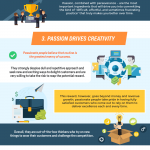Two Simple Steps To Sell Anybody On Your Vision
Something needs to change, and you think you know how. In other words, you’ve got a vision, and now you just need to sell it to other people. To help you out, there are two basic facts of psychology you need to know. First, persuading anybody of anything means connecting with what matters to them already. And second, when it comes to what matters to people–in other words, what motivates them–most people fall along a spectrum.
There are people who tend to be more motivated by preventing loss, while others are more driven by pursuing gains. Our relative positions on that spectrum aren’t fixed; we tend to move along it according to circumstances. But when it comes to getting buy-in, it’s useful to think of your audience as made up of two groups: “protectors” and “innovators.” Here’s how to win them both over, in this order:
Step 1: Engage The Protectors
For some people, the top priority is protecting what they already have. That means they’ll fear that whatever you’re suggesting needs to change may lead to something important being lost. For them, you need to remove the risk out of that threat.
You may be tempted to start by selling your vision based on what there is to gain, then end with reassurances that it’ll all work out as planned. Don’t do that. Start by identifying who the protectors are, and speak to their fears first.
When people focus on avoiding losses, they tend to regard a vision for change with suspicion. Like antibodies in the bloodstream that attack foreign organisms before they have a chance to spread, “protectors” will smother an idea that appears to be a threat before it can be considered for its merits.
So take the time to understand how these people define their teams’ core strengths and values. Let them know you respect what they stand for and share their beliefs. Every organization has a competitive advantage that sustains its success, and that’s the thing many protectors fear sacrificing. To show them you’re just as committed to protecting it, you need to demonstrate what the real risk is by not getting on board. Explain that change is necessary because the status quo is already under threat.
Frame your vision for change as serving the purpose of staying safe and successful. If your vision is to introduce virtual reality (VR) for military training, you’d want to point out to protectors that combatants in the future will ultimately gain access to that tool. In order to maintain a battlefield advantage, it’s crucial to explore the technology’s possibilities early on.
Two things to keep in mind. First, you only have to convince the protectors that your pitch is worth considering. By pointing out the new normal–the inevitable change you’re facing no matter what choice you make (or don’t make)–your proposal becomes much less of a threat to the status quo. And second, every organization has invested in people who keep things as they are, and there are more of them in bigger, more mature organizations. So the more stakeholders who are incentivized to defend the status quo, the more protectors you’ll likely need to win over.
Step 2: Inspire The Innovators
Protectors are the gatekeepers to change. Once through the gate, it’s time to connect with the “innovators” who’ll help you push your vision forward.
These are the risk takers, those who probably ruffle feathers now and then, but keep their teams dynamic and agile. Innovators can be your champions because they want to be at the forefront of change. So as someone with a vision to sell, you may find the innovators easy to talk to. They are like-minded. They speak your language. Like you, they willingly point out that the status quo has flaws.
But be wary of this easy rapport–it can be deceptive. Innovators aren’t as easily won over as you might think. You can’t race ahead until you’ve engaged them properly. After all, organizations will only take so many risks, which means they’ll only allocate so many resources to the few risks they do take. Great innovators understand this scarcity, and likely have ideas of their own. They know that taking on your vision means forgoing another one.
So just as with protectors, you have to start by finding out what matters to the innovators in your audience. But the difference is that they’re more interested in what there is to gain in your vision: How it is new? How it can help them achieve their visions? How it can help them gain what they’ve been seeking?
Frame your vision as a shared vision. Help them see how they stand to gain in their own agendas. This means listening and incorporating what you hear. Let the innovators mold your idea. Don’t cling to it inflexibly; they can probably make it better. So let them do it, and give them credit for it. Gaining credit for moving the organization forward is often what innovators crave. You lose nothing by giving credit. Credit is like fire; it grows brighter the more it’s shared. And nothing will make you look better than to have the organization’s most respected innovators rallying around you.
Their engagement is key for the long term. Selling an idea is simple compared to the uphill battle of implementing it. Successful innovators have learned they’re only rewarded once a great idea is actually implemented and begins to prove itself. In order for that to happen, you need champions all along the way.
With the protectors on board first and the innovators energized second, now you can clinch the deal. You’ve just got to secure the right people with the right messages in the right order.
We aren’t all motivated by the same things. And the bigger the company, chances are the more polarization you’ll find along this spectrum. But the basic formula is the same: Start by showing protectors how they’ll avoid losing ground, and then show innovators how they’ll be better off.
Josh Davis, PhD, is the author of Two Awesome Hours: Science-Based Strategies to Harness Your Best Time and Get Your Most Important Work Done and teaches “The Art of Public Speaking” at the NLP Center of New York. He is also the director of research and lead professor for the NeuroLeadership Institute. Kenny Davis is chief marketing officer at the toy company GoldieBlox.
Fast Company , Read Full Story
(10)














